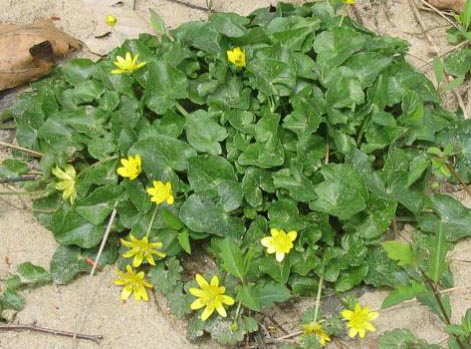Less Is More With Lesser Celandine
By Gretchen Spencer, Fairfax Master Gardener
What is shiny green and bright yellow and spreads ALL over? Not daffodils or dandelions or buttercups, but lesser celandine. Watch out for this weed!

Lesser celandine
I had seen this weed in wooded areas near a parkland stream that borders our neighborhood, but I didn’t pay much attention to it until this year, when I noticed that it had formed extensive, dense mats in several areas. My curiosity led me to research what I originally had thought was a wildflower.
Identification
Lesser celandine is easy to spot. Its glossy, green leaves are heart or kidney shaped, with toothed margins. Its bright, buttery-yellow flowers have eight to 12 narrow, oval petals with darker-yellow centers. The plant has a basal rosette of leaves and a single stem that supports the flower. Pulling up the plant reveals many small tubers produced by the roots. Because of its tubers and seeds, lesser celandine is easily spread by animals or when disturbed in any way. In our neighborhood, I suspect water is the conduit; tubers and seeds spread as the stream sweeps its banks during rainstorms.

Tubers attached to roots of lesser celandine
A member of the Buttercup family (Ranunculaceae), lesser celandine is native to Europe and Asia. Originally brought to the United States as an ornamental plant, it is now found throughout the Northeast, west to Michigan and Missouri and in several Pacific Northwest states. Lesser celandine is found in open woods, floodplains, meadows and waste places. It seems to prefer sandy soils. The area where it grows abundantly in my neighborhood has sandy soil. However, I have spied it in small patches in neighbors’ yards, as well as in my own.
Beware look-alikes
Do not confuse lesser celandine with marsh marigold (Caltha palustris), a desirable native plant found in wetland areas. Marsh marigold also has yellow flowers and shiny leaves. However, it does not produce tubers or bulblets or form a dense carpet.
Ecological threat
Lesser celandine is considered an ecological threat and a noxious weed. Because of its life cycle and vigorous, invasive, growth habit, it threatens native spring ephemerals. In our woods, west of where I noticed the dense mats of lesser celandine, native May apples (Podophyllum peltatum) and cutleaf toothwort (Cardamine concatenata) were both thriving because they are not yet competing with lesser celandine. However, these native plants days are numbered unless we control the lesser celandine.
Life cycle
Lesser celandine is a perennial. Its leaves appear in winter, earlier than most spring ephemerals. This head start helps it compete with early spring plants that emerge to capture the sun’s rays before deciduous trees leaf out. Lesser celandine begins flowering in March and blooms through May in the mid-Atlantic region. After flowering, the plants set seed and go dormant. By June they are mostly gone.
Control
Lesser celandine is difficult to control. Try removing small patches by pulling, but be careful not to leave behind any fingerlike tubers or to scatter them inadvertently. You can treat large, dense patches with a systemic herbicide in late winter/early spring, before native wildflowers or amphibians emerge. The University of Maryland recommends using glyphosate (Roundup, for example) in mid-February to early April, when the temperature is 50 degrees F, and no rain is expected for 12 hours.
We should all aim to remove small lesser celandine patches from our yards or gardens, but it is not an easy task. The trickiest part is making sure all the little tubers attached to the roots come up intact. This is one tenacious, productive weed!
References
Lesser Celandine, Washington State Noxious Weed Control Board
Fact Sheet: Lesser Celandine, Plant Conservation Alliance’s Alien Plant Working Group
Weed of the Week — Lesser Celandine, University of Maryland Extension
Maine Invasive Plants, Lesser Celandine, Cooperative Extension Publication #2534, The University of Maine